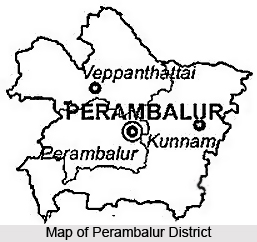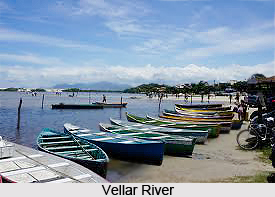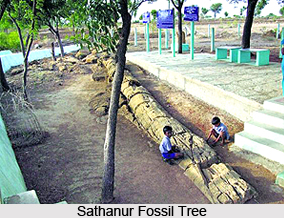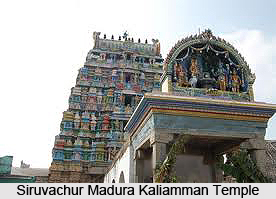 Perambalur district came into existence after the trifurcation of the Tiruchirappalli district with effect from the 30th of September 1995. The district of Perambalur with Headquarters at Perambalur consists of one revenue division of Perambalur and three taluks of Kunnam, Perambalur and Veppanthattai. The district is bounded on the North by Cuddalore and Salem districts, on the South by Tiruchirappalli, on the East by Ariyalur district, on the West by Tiruchirappalli and Salem districts. According to the 2001 Census the total population of the district of Perambalur is 4, 93,646. The density of population in the district is three hundred and twenty two per square kilometers. This district in the state of Tamil Nadu is fairly rich in mineral deposits. Celeste, shale, lime stone, canker, sand stone and phosphate nodules occur at a number of places in the district.
Perambalur district came into existence after the trifurcation of the Tiruchirappalli district with effect from the 30th of September 1995. The district of Perambalur with Headquarters at Perambalur consists of one revenue division of Perambalur and three taluks of Kunnam, Perambalur and Veppanthattai. The district is bounded on the North by Cuddalore and Salem districts, on the South by Tiruchirappalli, on the East by Ariyalur district, on the West by Tiruchirappalli and Salem districts. According to the 2001 Census the total population of the district of Perambalur is 4, 93,646. The density of population in the district is three hundred and twenty two per square kilometers. This district in the state of Tamil Nadu is fairly rich in mineral deposits. Celeste, shale, lime stone, canker, sand stone and phosphate nodules occur at a number of places in the district.
History of Perambalur District
In the year 1741, the Marathas invaded Tiruchirapalli and took Chanda Saheb as captive. However, Chanda Saheb was able to secure freedom in the year 1748, and soon got involved in the Great War for the Nawab`s place in the Carnatic against Anwardeen, the Nawab of Arcot and his son Mohammed Ali. Mohamed Ali annexed the two palayams of Udayarpalayam and Ariyalur situated within the present district of Ariyalur on the grounds of default in payment of tributes and failure to help him in suppressing the rebellion of Yusuf Khan. In the month of November 1764, Mohamed Ali represented the issue to Madras Council and received military assistance on the 3rd of January 1765.
 The forces led by Donald Campbell and Umdat-Ul-Umara entered Ariyalur and captured it and the young Poligar with his followers escaped to Udayarpalayam. On the 19th of January, the army marched towards Udayarpalayam. The troops of Poligar were defeated and the palayams were occupied. The two poligars fled away and took refuge in Tharangampadi, which was then a Danish settlement. The annexation of the palayam gave the Navab an undisputed possession of all his territories extending Arcot to Tiruchirappalli.
The forces led by Donald Campbell and Umdat-Ul-Umara entered Ariyalur and captured it and the young Poligar with his followers escaped to Udayarpalayam. On the 19th of January, the army marched towards Udayarpalayam. The troops of Poligar were defeated and the palayams were occupied. The two poligars fled away and took refuge in Tharangampadi, which was then a Danish settlement. The annexation of the palayam gave the Navab an undisputed possession of all his territories extending Arcot to Tiruchirappalli.
The history of this district followed a power struggle between Hyder Ali and later Tipu Sultan with the British. After the death of Tipu Sultan, the British took the civil and military administration of the Carnatic in the year 1801. Thus Tiruchirappalli came into the hands of the English and the district was formed in the year 1801. In the year 1995, Tiruchirappalli was trifurcated and the new Perambalur district and Karur district were formed.
Geography of Perambalur District
Perambalur district is located centrally in the south Indian state of Tamil Nadu and is about two hundred and sixty seven kilometers away, in southern direction, from Chennai. The district of Perambalur has an area of three thousand six hundred and ninety one square kilometers and it spreads between 10.54` and 11.30` degree on the Northern latitude and 78.40` and 79.30` degree on the Eastern longitude. This is an inland district without any coastal line. The district has Vellar River in the North and it has well-marked natural divisions. The Pachamalai hill situated on the Northern boundary of Perambalur district is the most important hill in the district.
The most prominent commercial crop grown in this district is sugarcane. The pre-dominate soil in the district of Perambalur is red sanding with scattered pockets of black soil. The soil in the Perambalur district is very much suitable for raising dry crops. This district possesses a high means of temperature and low degree of humidity.

Tourism in Perambalur District
One of the major tourist attractions in the district of Perambalur is the Ranjankudi Fort which attracts a large number of tourists from different parts of the state as well as from other portions of the country throughout the year. There are also several temples which serve as some of the best places of pilgrimage where devotees and also general tourists visit. The Siruvachur Madura Kaliamman temple at Siruvachur in Perambalur taluk is one of the most popular shrines in the district. The main annual festival at this temple commences in the last week of Panguni. The Car festival is celebrated in the first week of Chithirai. Other temples of importance in this district are the Ancient Arulmigu Ekambareswar and Thandayuthapani Temples. These temples are situated in the Chettikulam Village. These temples were constructed by King Kulasekara Pandian, about eight hundred years ago. These two temples are located at a distance of twenty two kilometers from Perambalur and eight kilometers to the west of Alathurgate on Trichy-Chennai National Highway.
Apart from the various temples, there is the Ranjankudi Fort in the Perambalur district which is situated about seventeen kilometers to the north of Perambalur. The Fort was constructed by Jaginthar under Nawab of Carnatic in the seventeenth century AD. The Fort was the scene of the battle of Valikondah between the British and Mohamed Ali on one side and Chandha Sahib and the French on the other side in A.D. 1751. The Ranjankudi Fort is under the protection of the Archaeological Survey of India. Another major attraction of the district of Perambalur is the Sathanur Fossil Tree.
 The petrified tree trunk at Sathanur measures over eighteen meters in length. Similar fossil trees measuring a few meters in length are also found along the stream sections near Varagur, Anaipadi, Alundalipur and Saradamangalam. The large trunk of petrified tree, which can be seen here, lies within the Trichinopoly group of rocks of about 100,000,000 years ago and it shows the presence of Conifers (non-flowering plants) which dominated the land vegetation before the advent of the present-day flowering plants or Angiosperms.
The petrified tree trunk at Sathanur measures over eighteen meters in length. Similar fossil trees measuring a few meters in length are also found along the stream sections near Varagur, Anaipadi, Alundalipur and Saradamangalam. The large trunk of petrified tree, which can be seen here, lies within the Trichinopoly group of rocks of about 100,000,000 years ago and it shows the presence of Conifers (non-flowering plants) which dominated the land vegetation before the advent of the present-day flowering plants or Angiosperms.
The Perambalur district is thus one of the composite districts of the state of Tamil Nadu formed after the trifurcation of the Tiruchirapalli district. This district is having its borders as the Cuddalore district, Salem district, Tiruchirappalli district and Ariyalur district. The beautiful temples in Perambalur district and other attractions like the Ranjankudi Fort and the Sathanur Fossil Tree form the major attractions of the district.



















